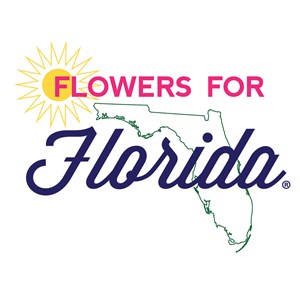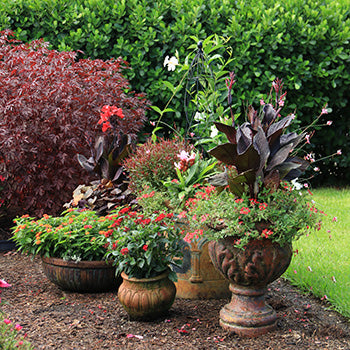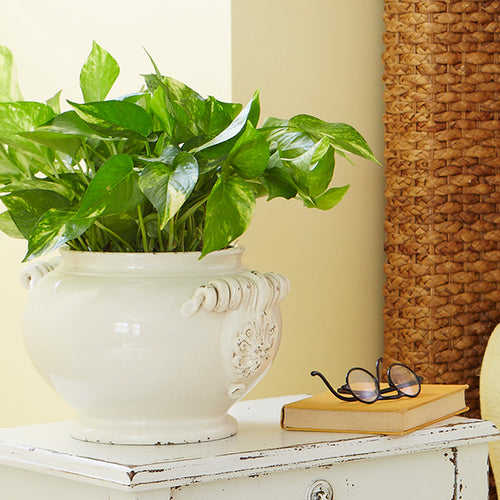By Karen Weir-Jimerson

Welcome to Gardening in North and Central Florida!
If you’re lucky enough to live in North Florida (hello Panhandle and Central FL folks), then you are blessed with lots of , a good bit of rain, and a long growing season. The good news is that means you can grow just about anything you want! In this guide, we’ll discuss what you need to know about gardening successfully in this part of the sunny state of Florida.
- Your Weather
- Your USDA Zones
- Last Frost Dates
- Your Soil
- Month-by-Month Gardening Tips
- Best Plants for North and Central Florida Gardens
Your Weather
(Here’s a fun FYI: Humid subtropical areas in the southeastern part of the US are like climates in eastern Australia, northern and south China.)
A rainy season, from May through October, occurs in north and central Florida. You may see more thundershowers during these months. Rains are brief and heavy.
Your USDA Zones
- Daytona Beach 9a, 9b
- Destin 8b
- Gainesville 9a
- Jacksonville Zone 8b, 9a
- Lake City 8b
- Ocala 9a
- Orlando 9b
- Panama Beach 8b, 9a
- Pensacola 9a
- Tallahassee Zone 8b
Last Frost Dates
Although it doesn’t seem possible, the temperatures can dip below freezing and it can even snow in North Florida! Here are the largest areas in and central Florida and their last frost dates. The last frost date is the average date in spring that your area could have a killing frost. A frost will kill anything that is not hardy to your USDA zone.
- Daytona Beach February 21-29
- Destin April 1-10
- Gainesville March 21-31
- Jacksonville Zone March 11-20
- Lake City March 21-31
- Ocala March 11-20
- Orlando February 21-29
- Panama Beach March 21-31
- Pensacola March 11-20
- Tallahassee Zone April 1-10
Your city/town not on the list above? See the last frost date map for Florida.
Your Soil
The state of Florida has an official state soil. It’s called Myakka. While Myakka soils can vary from clay like to sandy, the makeup of the soil is generally mostly sand. The fine of Florida is great for beaches but not so beneficial for gardeners. Sandy soil has little organic material so it has few nutrients and doesn’t hold moisture well. Most soil should be improved with some organic material such as compost. If you want to garden in containers or raised bed, you can fill both with potting soil, which is rich in both nutrients and organic materials. Learn more about the soil of Florida.
Month-by-Month Gardening Tips
JANUARY
Plant cool-weather annuals.
Brighten your yard with cool-loving flowering annuals such as petunia, snapdragon, viola, pansy, and flowering kale.
Watch for cold snaps.
Monitor moisture levels in .
Prune up to shape shrubs.
Plant cold crops.
Fertilize citrus trees.
FEBRUARY
Plant more annual flowers.
Create containers or beds using annual flowers that can take cool snaps, such as pansy and dianthus.
Plant more cool-weather vegetables.
Sow more lettuce, and radishes in your veggie garden. Plant every 2 weeks for continuous harvests.
Plant potatoes.
Drop seed potato pieces into the garden or a container and cover with 3 inches of soil.
Prune and fertilize roses.
Cut back dead or straggly canes for general shape up. Fertilize and mulch around plants.
Plant bulbs.
Agapanthus and crinum bulbs can be planted now. Mulch heavily to keep protected from cold snaps.
Here are other fun plant-related things to do in February.


MARCH
Plant window boxes and containers.
Use showy annual flowers to brighten up your porch and patio for spring. Angelonia, dusty miller, and violas are good options.
Prune and fertilize.
After camellias and azaleas have completed blooming, clip back for general shape up. Fertilize and mulch around plants.
Feed palms.
Dig in a fertilizer around the base of plants. Keep palms well watered during dry seasons.
Plant warm-weather vegetables.
Plant tomatoes, peppers, squash, and corn for late spring harvests.
Plant summer-blooming bulbs.
Summer flowering bulbs, such as cannas, dahlias, and gloriosa lilies, can be planted now.
Here are other fun plant-related things to do in March.
APRIL
Add warm-weather annuals to the mix.
As the weather heats up, replace cool-weather annuals such as snapdragons and viola with annuals that stand up to heat, such as coleus, marigolds, and petunias.
Plant tropicals.
Caladiums and calla lilies can go into the garden this month. Add these beauties the entryway of your home to welcome guests.
Move houseplants outdoors.
Indoor plants, such as snake plant and majesty palms welcome fresh air and rain. Place plants in a shaded spot so they don’t get burned. Read more about moving houseplants outdoors.
Plant perennial grasses.
Pink muhly grass loves soil and is ideal for north Florida gardens, especially coastal ones. waving pink fronds will be your reward in autumn.
Add more warm-weather crops.
Plant herbs, tomatoes, and peppers so summer salsas.
Divide perennials and bulbs.
Pop overgrown clumps out of the ground, slice into pieces and replant.
Plant flowering trees.
Bottle brush, redbud, and tree can all be planted this month.
Grow up. Tropical vines such as mandevilla are ideal for patio containers.
Here are some other fun plant-related things to do in April.


MAY
Watch for pests.
Mites and thrips like warm weather. And tomato may be looking for a meal. Oleander caterpillars may appear (on oleanders). Inspect plants for interlopers and treat with remedy for that particular pest. Not all insects are bad though. Many insects are harmless or even beneficial.
Plant an herb garden.
Basil, cilantro, and dill seeds can be sown or seedlings planted.
Add rosemary.
Rosemary loves the sandy soil of north Florida, so plant several types. This perennial herb is ideal for seasoning fish, pasta, and vegetable dishes.
Supplement moisture.
Keep beds and containers well watered as the temperatures rise. Check irrigation heads to make sure shrubs and other plantings are getting water.
Plant heat-loving annuals.
As the temperatures rise, so will colorful annuals. Angelonia, salvia, and zinnia can take the heat.
Clean up dead in trees and shrubs.
Remove broken or dead limbs before hurricane season starts.
Here are some other fun plant-related things to do in May.
JUNE
Plant palms.
Add palms to your landscape. It’s the ideal time to plant because June’s rainfall will help water in this thirsty plant.
Add perennials to the landscape.
Sun-loving perennials, such as black-eyed Susan and grasses add long-term color to your yard.
Mix in edibles with flowers.
Herbs such as basil and rosemary, make great bed additions that you can clip when cooking.
Add bright color.
Bright annuals stand up in beds and borders. Try flame-colored celosia, hot pink portulaca, and eye-catching red-and-green coleus.
Put the brakes on fertilizing.
Some areas of north Florida ban fertilizing lawns and gardens during the rainy months of June through September.
Here are some other fun plant-related things to do in June.


JULY
Check irrigation.
North Florida’s hot weather makes it necessary to keep up moisture levels in containers and borders. But don’t overwater this month. Install a rain shut-off device to conserve water. Rainfall is plentiful.
Kill weeds in vegetable beds.
Get ready for fall crops by solarizing garden beds (in the sun) with clear plastic. It takes about 4 weeks to entirely kill weeds, pests, and diseases—just in time for a healthy fall garden.
Remove spent blooms.
Keep annuals and perennials looking great by removing the spent flowers from plants; this is called deadheading.
Prune azaleas.
Shape azaleas no later than July, or you’ll cut off flower buds.
Plant bulbs.
Add society garlic and gladiolus to summer gardens now.
Start pumpkin seeds.
If you want to grow your own jack-o-lanterns, start seeds now.
Here are some other fun plant-related things to do in July.
AUGUST
Color up.
Add heat-tolerant annuals to containers and window boxes for a summer . Try gaillardia, lantana, calibrachoa, and pentas. Here are more colorful flower options.
Plant a perennial herb garden.
Rosemary, ginger, and bay laurel can all be planted in August’s sultry weather.
Add more heat-loving veggies.
You still have several months of hot weather, so tuck in more tomatoes, lima beans, cucumbers, and eggplants.
Check palms.
Are fronds turning yellow? It might be due to a magnesium or potassium deficiency. Fertilize now.
Nip and tuck the garden.
Deadhead and trim back leggy growth to make your August garden neater and trimmer.
Pinch .
A little pinch for now will lead to bigger bushier plants.
Here are some other fun plant-related things to do in August.

.jpg)
SEPTEMBER
Boost fall color.
Add annuals to beds and borders to add fresh color. Ageratum, zinnia, and begonias are reliable and beautiful choices.
Plant strawberries.
Get started on strawberry shortcake season but planting these perennial berries now.
Add plants for hummingbirds.
Hummingbirds are on the move and looking for nectar-rich blooms such as trumpet vine, salvia, and bee balm.
Start your fall veggie garden.
September is your second cool-crop gardening season, so plant greens, carrots, and radishes again.
Divide perennials and bulbs.
Dig up overgrown clumps of perennials and bulbs and divide them. Replant elsewhere in the garden or give to friends and family as plants.
Add perennials for shade.
Now is a good time to tuck in some shade-loving perennials into beds and borders. See our design ideas for a shaded yard.
Keep an eye on weeds.
Minimize weeding chores by plucking weeds from the garden when they are small (and have weak root systems).
Here are some other fun plant-related things to do in September.
OCTOBER
Add plants for migrating butterflies.
Zebra Heliconia, Monarchs, and Gulf Fritillary butterflies are all on the move. Plant plumbago, pentas, lantana, and salvia for nectar meals. Add host plants for the butterflies you want to attract.
Plant evergreen shrubs.
If you like to trim holly branches for the holidays, plant a couple of these red-berried, glossy leafed beautifies.
Gather pine needles for mulch.
If you have pines in your area, you have access to natural, local, and plentiful mulch. Add a thick around perennials, and trees to help maintain moisture levels. Mulch makes beds look better too.
Plant herb seeds.
Can you ever have enough herbs? Plant annual herbs such as cilantro and basil for quick and flavorful additions to salads and soups.
Halloween containers.
Tuck flowering kale and into containers for porches and patios to give an autumnal feel. If you planted pumpkins or gourds, add them to baskets and tabletops.
Here are some other fun plant-related things to do in October.


NOVEMBER
Add cool-weather annuals.
Brighten up your entryway with a swath of pansies or violas. These cool-weather beauties will last all winter.
Plant in containers.
Moveable feasts of color, add dashing color wherever you place them. Add them to containers with flowering kales and little gourds and pumpkins.
Plant bulbs for the holidays.
If you love those amaryllis blooms for the plant now. Add crinum in your borders and beds.
Plant a vitamin garden.
Cool weather, antioxidant-rich greens can be grown now: kale, spinach, arugula.
Cooler temps mean your garden needs less water.
Adjust irrigation schedules.
Plant flowering trees and shrubs.
November’s cooler temperatures are ideal for planting camellias, azaleas, and citrus trees.
Bring houseplants indoors.
Before cold weather sets in, bring summering houseplants back indoors.
Here are some other fun plant-related things to do in November.
DECEMBER
Check houseplants for pests.
Inspect houseplants for hitchhiking pests if they summered outdoors. Wipe leaves clean. if rootbound.
Clean up garden beds.
Remove spent vegetable plants, clip up perennials, and change out annuals to freshen up before the New Year.
Add holiday color.
Add traditional live greenery to your porches and dining rooms this month. Ivy, rosemary and orchids all make festive holiday décor.
Here are some other fun plant-related things to do in December.

Best Plants for North and Central Florida Gardens
The Flowers for Florida collection is just for Florida gardeners. These plants bloom beautifully and hold up to Florida's tough weather. If you're new to gardening in the state or just want something that's easy to grow, look no than Flowers for Florida. Because different plants do better in certain seasons, we adjust the plants in the collection accordingly -- so visit your local garden center every few months to see what varieties do best throughout the entire year. We try to have varieties for everyone -- whether you want to plant in sun or shade; attract butterflies or are looking for tall or short plants. Plus, they grow in landscape beds and borders as well as container gardens.
Looking for Costa Farms Plants?
Check our favorite local garden center or one of our other retailer partners to order them online!
















